#Clinical Trials
Text

Story from the Washington Post here, non-paywall version here.
Washington Post stop blocking linksharing and shit challenge.
"The young woman was catatonic, stuck at the nurses’ station — unmoving, unblinking and unknowing of where or who she was.
Her name was April Burrell.
Before she became a patient, April had been an outgoing, straight-A student majoring in accounting at the University of Maryland Eastern Shore. But after a traumatic event when she was 21, April suddenly developed psychosis and became lost in a constant state of visual and auditory hallucinations. The former high school valedictorian could no longer communicate, bathe or take care of herself.
April was diagnosed with a severe form of schizophrenia, an often devastating mental illness that affects approximately 1 percent of the global population and can drastically impair how patients behave and perceive reality.
“She was the first person I ever saw as a patient,” said Sander Markx, director of precision psychiatry at Columbia University, who was still a medical student in 2000 when he first encountered April. “She is, to this day, the sickest patient I’ve ever seen.” ...
It would be nearly two decades before their paths crossed again. But in 2018, another chance encounter led to several medical discoveries...
Markx and his colleagues discovered that although April’s illness was clinically indistinguishable from schizophrenia, she also had lupus, an underlying and treatable autoimmune condition that was attacking her brain.
After months of targeted treatments [for lupus] — and more than two decades trapped in her mind — April woke up.
The awakening of April — and the successful treatment of other people with similar conditions — now stand to transform care for some of psychiatry’s sickest patients, many of whom are languishing in mental institutions.
Researchers working with the New York state mental health-care system have identified about 200 patients with autoimmune diseases, some institutionalized for years, who may be helped by the discovery.
And scientists around the world, including Germany and Britain, are conducting similar research, finding that underlying autoimmune and inflammatory processes may be more common in patients with a variety of psychiatric syndromes than previously believed.
Although the current research probably will help only a small subset of patients, the impact of the work is already beginning to reshape the practice of psychiatry and the way many cases of mental illness are diagnosed and treated.
“These are the forgotten souls,” said Markx. “We’re not just improving the lives of these people, but we’re bringing them back from a place that I didn’t think they could come back from.” ...
Waking up after two decades
The medical team set to work counteracting April’s rampaging immune system and started April on an intensive immunotherapy treatment for neuropsychiatric lupus...
The regimen is grueling, requiring a month-long break between each of the six rounds to allow the immune system to recover. But April started showing signs of improvement almost immediately...
A joyful reunion
“I’ve always wanted my sister to get back to who she was,” Guy Burrell said.
In 2020, April was deemed mentally competent to discharge herself from the psychiatric hospital where she had lived for nearly two decades, and she moved to a rehabilitation center...
Because of visiting restrictions related to covid, the family’s face-to-face reunion with April was delayed until last year. April’s brother, sister-in-law and their kids were finally able to visit her at a rehabilitation center, and the occasion was tearful and joyous.
“When she came in there, you would’ve thought she was a brand-new person,” Guy Burrell said. “She knew all of us, remembered different stuff from back when she was a child.” ...
The family felt as if they’d witnessed a miracle.
“She was hugging me, she was holding my hand,” Guy Burrell said. “You might as well have thrown a parade because we were so happy, because we hadn’t seen her like that in, like, forever.”
“It was like she came home,” Markx said. “We never thought that was possible.”
...After April’s unexpected recovery, the medical team put out an alert to the hospital system to identify any patients with antibody markers for autoimmune disease. A few months later, Anca Askanase, a rheumatologist and director of the Columbia Lupus Center,who had been on April’s treatment team, approached Markx. “I think we found our girl,” she said.
Bringing back Devine
When Devine Cruz was 9, she began to hear voices. At first, the voices fought with one another. But as she grew older, the voices would talk about her, [and over the years, things got worse].
For more than a decade, the young woman moved in and out of hospitals for treatment. Her symptoms included visual and auditory hallucinations, as well as delusions that prevented her from living a normal life.
Devine was eventually diagnosed with schizoaffective disorder, which can result in symptoms of both schizophrenia and bipolar disorder. She also was diagnosed with intellectual disability.
She was on a laundry list of drugs — two antipsychotic medications, lithium, clonazepam, Ativan and benztropine — that came with a litany of side effects but didn’t resolve all her symptoms...
She also had lupus, which she had been diagnosed with when she was about 14, although doctors had never made a connection between the disease and her mental health...
Last August, the medical team prescribed monthly immunosuppressive infusions of corticosteroids and chemotherapy drugs, a regime similar to what April had been given a few years prior. By October, there were already dramatic signs of improvement.
“She was like ‘Yeah, I gotta go,’” Markx said. “‘Like, I’ve been missing out.’”
After several treatments, Devine began developing awareness that the voices in her head were different from real voices, a sign that she was reconnecting with reality. She finished her sixth and final round of infusions in January.
In March, she was well enough to meet with a reporter. “I feel like I’m already better,” Devine said during a conversation in Markx’s office at the New York State Psychiatric Institute, where she was treated. “I feel myself being a person that I was supposed to be my whole entire life.” ...
Her recovery is remarkable for several reasons, her doctors said. The voices and visions have stopped. And she no longer meets the diagnostic criteria for either schizoaffective disorder or intellectual disability, Markx said...
Today, Devine lives with her mother and is leading a more active and engaged life. She helps her mother cook, goes to the grocery store and navigates public transportation to keep her appointments. She is even babysitting her siblings’ young children — listening to music, taking them to the park or watching “Frozen 2” — responsibilities her family never would have entrusted her with before her recovery.
Expanding the search for more patients
While it is likely that only a subset of people diagnosed with schizophrenia and psychotic disorders have an underlying autoimmune condition, Markx and other doctors believe there are probably many more patients whose psychiatric conditions are caused or exacerbated by autoimmune issues...
The cases of April and Devine also helped inspire the development of the SNF Center for Precision Psychiatry and Mental Health at Columbia, which was named for the Stavros Niarchos Foundation, which awarded it a $75 million grant in April. The goal of the center is to develop new treatments based on specific genetic and autoimmune causes of psychiatric illness, said Joseph Gogos, co-director of the SNF Center.
Markx said he has begun care and treatment on about 40 patients since the SNF Center opened. The SNF Center is working with the New York State Office of Mental Health, which oversees one of the largest public mental health systems in America, to conduct whole genome sequencing and autoimmunity screening on inpatients at long-term facilities.
For “the most disabled, the sickest of the sick, even if we can help just a small fraction of them, by doing these detailed analyses, that’s worth something,�� said Thomas Smith, chief medical officer for the New York State Office of Mental Health. “You’re helping save someone’s life, get them out of the hospital, have them live in the community, go home.”
Discussions are underway to extend the search to the 20,000 outpatients in the New York state system as well. Serious psychiatric disorders, like schizophrenia, are more likely to be undertreated in underprivileged groups. And autoimmune disorders like lupus disproportionately affect women and people of color with more severity.
Changing psychiatric care
How many people ultimately will be helped by the research remains a subject of debate in the scientific community. But the research has spurred excitement about the potential to better understand what is going on in the brain during serious mental illness...
Emerging research has implicated inflammation and immunological dysfunction as potential players in a variety of neuropsychiatric conditions, including schizophrenia, depression and autism.
“It opens new treatment possibilities to patients that used to be treated very differently,” said Ludger Tebartz van Elst, a professor of psychiatry and psychotherapy at University Medical Clinic Freiburg in Germany.
In one study, published last year in Molecular Psychiatry, Tebartz van Elst and his colleagues identified 91 psychiatric patients with suspected autoimmune diseases, and reported that immunotherapies benefited the majority of them.
Belinda Lennox, head of the psychiatry department at the University of Oxford, is enrolling patients in clinical trials to test the effectiveness of immunotherapy for autoimmune psychosis patients.
As a result of the research, screenings for immunological markers in psychotic patients are already routine in Germany, where psychiatrists regularly collect samples from cerebrospinal fluid.
Markx is also doing similar screening with his patients. He believes highly sensitive and inexpensive blood tests to detect different antibodies should become part of the standard screening protocol for psychosis.
Also on the horizon: more targeted immunotherapy rather than current “sledgehammer approaches” that suppress the immune system on a broad level, said George Yancopoulos, the co-founder and president of the pharmaceutical company Regeneron.
“I think we’re at the dawn of a new era. This is just the beginning,” said Yancopoulos."
-via The Washington Post, June 1, 2023
#mental illness#schizophrenia#schizoaffective#psychotic disorders#psychology#neurology#autoimmune#autoimmine disease#neuroscience#medical news#medical research#catatonia#immunotherapy#immune system#clinical trials#good news#hope
6K notes
·
View notes
Text
Ch204 (p2), Bodies and souls
The head matron drops that bomb from ch203 that Theo is to fledge next.

I'm a bit confused why they mention Nick, except that he would be the next candidate for real Ciel, if Theo wasn't there. I was worried for a moment there that they had already fledged Nick without us even knowing about it. However, they talk about Ginny in past tense and Nick in present tense, so he must still be there.
Gosh, this young Black lady here. I hope she turns against the orphanage, because I can tell she feels deeply that this is not acceptable. Partly, she is asking because she doesn't know everything that the head matron has already been told, or perhaps she has forgotten what she was already told. Either way, she still wonders why it has to be like this.
The head matron uses the same terms Blavat used at Sphere Music Hall: radiance, stars. However, "aptitude" has been added. She acts like it's these "stars" themselves who "possess technologies way more advanced" that theirs, as if they are from some advanced alien civilization.

It's odd for her to talk about not just their bodies but also specifically their souls. Someone has told her that their souls need to be as similar to the souls of the "stars", too, not just a match in their bodies. This reminds me of what was told (probably by Undertaker) to Chris Heathfield, and that the baron repeated to Jane.
So, I'm definitely not giving up my theory that Undertaker is experimenting with soul transplants, too, not just blood transfusions and organ transplants. To him, a soul is basically an organ, anyway, right? It could be that the best way for them to match their souls is by assessing their aptitudes. It's not just the blood typing, it's the combination of blood type and aptitude test results. And then reinforcing the similarities. She even has the nerve to call this a "clinical trial".
But Susan doesn't care too much about the details, as she hopes to use her high earnings to leave soon and open her own business, some sort of shop. I wonder where the money is coming from to keep paying such high wages, since we saw those money-donating renal patients die, but it could be coming from the hotel resort in Brighton....

Susan goes to the cold vault to get blood for Doll, and we see they have also been storing blood for the other lords of the stars. Though it's possible they don't currently have any for Sirius, which would help explain why a Pomeranian like Theo would be next.

Now this is interesting. "Things are taking longer this time"... compared to what? Last time Doll needed blood? Or something else about Doll's condition? What, exactly, is taking longer this time? 🤔
#black butler#kuroshitsuji#ch204#chapter release#chapter review#chapter analysis#fol orphanage#susan#staff#ginny#doll#blood types#blood transfusion#soul transplants#experiments#clinical trials#soul shapes#shapes of souls#theo#theodore#lords of the stars#radiance#lord canopus#lord sirius#sep 15 2023#part two#part 2
77 notes
·
View notes
Text


More information about Stanford research goals and the RECOVER Program/Initiative:
#covid-19#covid 19#sars cov 2#covid#long covid#long haul covid#Stanford#Clinical Trials#Paxlovid#Antivirals#Research#RECOVER#RECOVER Program#National Institute of Health#NIH#Institutonal Review Board#IRB
90 notes
·
View notes
Text
Good News From Israel
Israel's Good News Newsletter to 17th Dec 23
In the 17th Dec 23 edition of Israel’s good news, the highlights include:
Two emotional family reunions during the war.
Two breakthroughs that help us understand how our brains work.
The world’s first approved laser cure for glaucoma.
Two typical examples of the IDF showing compassion, even in war.
Israelis are making the world’s most powerful telescope and miniature cameras.
Two private initiatives to regenerate Gaza border agricultural communities.
A national Torah scroll is being written to immortalize victims of Oct 7.

So many positive news articles last week focused on regenerating life for individuals, communities and in other areas.
Medical regeneration involved rehabilitating wounded IDF personnel; reuniting separated families; two Israeli therapies for regenerating the lives of traumatized children, and another that generates companionship for the elderly. Israelis are able to generate thousands of clinical trial simulations, regenerate eye functionality in glaucoma patients, and can show how dormant bacteria regenerates. An Israeli female Israeli professor is responsible for generating three startups including one that regenerates spinal cords. And an Israeli IDF reservist donated her bone marrow to regenerate a patient's immune system.
Read about the The volunteers and organizations that have been regenerating neglected farms in Israel's south; and the food rescue startup that has been regenerated after shutdown during the Covid pandemic. Israel is 3rd in the world for Generative AI startups (see newsletter for details) and one startup even generates responses to hate speech. Other Israeli startups regenerate machinery at risk of breaking down and recharge electric buses wirelessly. Many startups have relocated to safer areas in Israel and begun regenerating their businesses with increased productivity. Finally, a combined religious and secular project to write Torah scrolls is regenerating the spiritual unity of the Jewish State.
The photo is of Hanukkah celebrations in Herzliya, which regenerated a much needed happy diversion among children and adults alike.
#Australia#civilians#clinical trials#Gaza#glaucoma#good news#Hamas#Hannukah#hate speech#IDF#Israel#Jerusalem#Jewish#kidney#mining#NASA telescope#RAFAEL#Torah#trauma#wireless charging
17 notes
·
View notes
Text
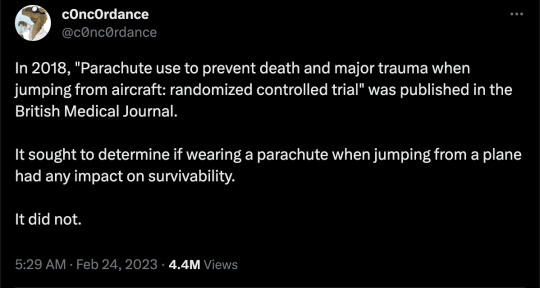





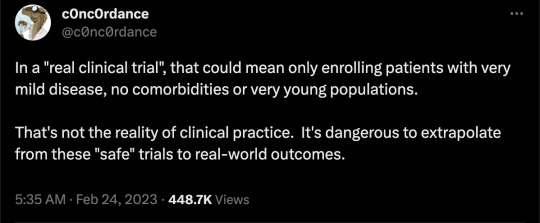







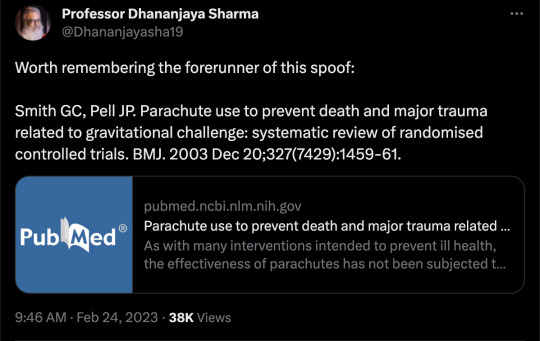
#randomized control trial#clinical trials#parachute use#parachute experiment#anti maskers#mask#medical studies#science#LOL#funny#religion is a mental illness
44 notes
·
View notes
Link
Researchers from Insilico Medicine designed and devised inClinico to predict Phase-II clinical trial outcomes. The transformer-based artificial intelligence software platform, inClinico, conjugates an ensemble of clinical trial outcome prediction (CTOP) engines that harness generative artificial intelligence and multimodal data that consolidates omics, text, clinical trial design, and small molecule properties. Integrating multimodal data sources, multiple scoring approaches, and biological background along with deep learning models, inClinico software generates a probability of success (PoS) against a Phase II clinical trial evaluation to furnish insight into the probability of Phase II success and, thereby, the transition from Phase II to Phase III. The inClinico CTOP models can be leveraged by the pharmaceutical industries to optimize funding and elevate productivity.
The success of Drug discovery and development is a blessing for civilization, but the expense and involvement of risk in terms of labor, finance, and time; that are associated with the entire process from the pre-discovery stage to marketing are enormous. Computer-aided techniques now ubiquitously complement the pre-discovery and discovery stages.
After that, the clinical trial phase alone takes 6-7 years. Generally, several thousand volunteers are clinically tested with the drug in Phase II. A prior notion about the likelihood of success in the clinical trial is advantageous regarding the effectiveness, the productivity of the R&D department of a pharma company and provides beneficial estimation in cutting down on irrelevant expenses due to failure and further financial investments.
Several attempts have been made to develop artificial intelligence technologies that will foretell whether the clinical trial will be successful. Such works included toxicity prediction through machine learning scoring ensemble based on drug descriptors and target features, drug-induced pathway activation and consequent side effects of a drug, a deep neural network to predict clinical trial outcomes using multimodal data on the molecule tested, etc.
Continue Reading
23 notes
·
View notes
Text
DAILY DOSE: Hottest August ever recorded is official; Revenant child discovered in Poland.
HOT HOT HEAT.
The World Meteorological Organization (WMO) reported that this year had the hottest Northern Hemisphere summer on record, with August as the warmest month ever documented. Temperatures in August were about 1.5°C higher than pre-industrial averages. Global oceans also reached record temperatures for three consecutive months. The surge in temperatures is attributed to human-induced…

View On WordPress
#Africa#archaeology#Asia#Australia#cancer#climate change#clinical trials#Europe#Featured#meterology#North America#South America#space exploration#technology
13 notes
·
View notes
Text
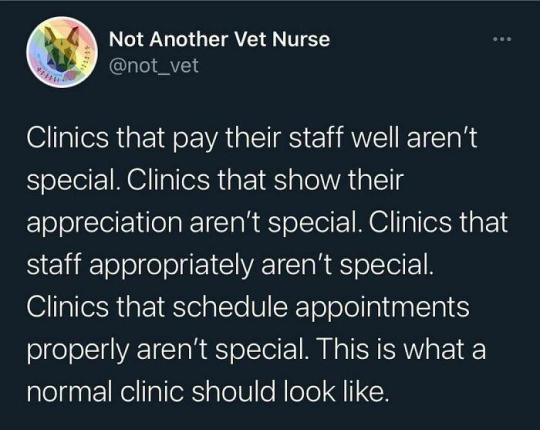
This is what a normal clinic should look like.
#This is what a normal clinic should look like.#clinics#dental clinic#clinicalstudy#clinical zoanthropy#clinical cynanthropy#clinical lycanthropy#clinic#ausgov#politas#auspol#tasgov#taspol#australia#fuck neoliberals#neoliberal capitalism#anthony albanese#albanese government#random facts#fun facts#interesting facts#jack facts#facts#charlie and the chocolate factory#fact#earth#clinical trials#just a general fyi#just fyi#also fyi
3 notes
·
View notes
Text
I am glad to know that Canada is working on trials for treating Long Covid.
2 notes
·
View notes
Text




23Aug22// Tomorrow is D-Day. Im signing up into new uni to start a brand new chapyer of my life.
Before I have studied Biology and got a degree in Physiology. I wrote my master thesis from Neurobiology and my whole life revolved around it. After uni, I started working for a corporate dealing with clinical trials (my job is administrative type)...and then it started. I got familiar with this administrative part of work, not only the scientific part. So I decided to start something new and I'd like to conquer this side of it as well.....soooo I have signed up for Master of Management
Wish me luck🍀
A caffeine addict 🐒
#studyblr#study#studyspo#studinspo#studinspiration#university#school#notes#studying#study motivation#academy#academia#dark academia#light academia#management#biology#neurobiology#clinical trials#clinic#clinical#administrative#administration#old student#extern#extern student#book#bookblr#bookspo#book inspiration
51 notes
·
View notes
Link
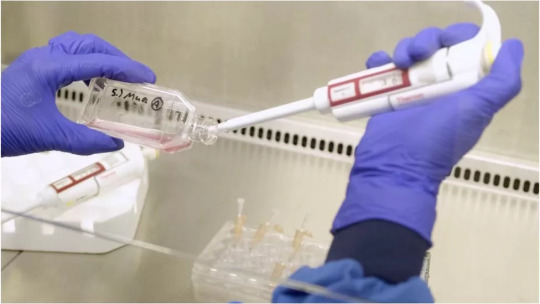
“British scientists have grown human red blood cells in a lab for the first time, and conducted a clinical trial to give it to patients.
The blood is grown by encouraging stem cells found in a blood donor’s sample to become new red blood cells, and opens the door to transfusion treatments for those with ultra-rare blood types.
For the near total majority of blood transfusions, British hospitals will still rely on people rolling up their sleeves and donating. This is, and will remain the case for, A, B, O, and AB blood types.
But what if a patient needs a blood transfusion of the “Bombay” blood group? It’s a tough call, as the British NIH knows of three people in the whole of the UK with this ultra-rare blood type.
Certain diseases, such as sickle-cell anemia, require regular blood transfusions, and if this patient were to also have the Bombay blood type, or “Jka-b-” or “Rh-null” also called “golden blood,” or “SARA” type after the first person it was discovered in, they are in serious danger...
“This world-leading research lays the groundwork for the manufacture of red blood cells that can safely be used to transfuse people with disorders like sickle cell,” said Dr. Farrukh Shah, the medical director of transfusion at NHS Blood and Transplant.” -via Good News Network, 11/16/22
#blood#medical research#medical science#blood type#sickle cell disease#good news#hope#clinical trials
30 notes
·
View notes
Text
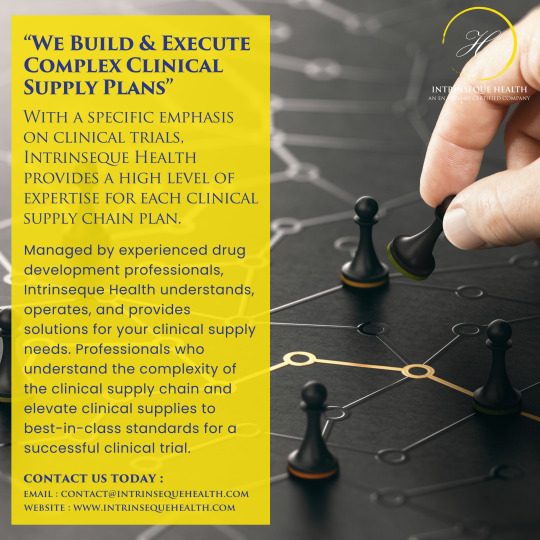
Intrinseque Health - Clinical Supply Chain
We Build and Execute Complex Clinical Supply Plans
Intrinseque Health is an EN ISO 13485 Certified Global clinical trial support services provider committed to the utmost in service delivery to drug development organizations (Pharmaceutical, Biotechnology, Medical Device & Contract Research Organizations (CROs)). Our team of industry professionals has over 300 years of combined experience supporting global clinical trials across a wide array of therapeutic areas. This vast experience enables us to empathize with our Customers while providing best-in-class solutions to overcome the hurdles and pain-points of conducting a clinical trial.
Regions & countries throughout the world will often present a unique set of regulatory and logistical challenges. It is our responsibility to understand and overcome these while ensuring that your products, supplies, equipment and services are available where needed to ensure study timelines are met. Intrinseque Health utilizes an operational methodology that is based on proven, cost-effective clinical supply chain strategy for each clinical trial. Our practice is to engage with our customers, early and often to ensure implementation of a robust clinical supply plan, resulting in the most successful study start-up and initiation.
#clinical supply#clinical trials#health#healthcare#supplychainmanagement#clinical supply chain#clinical supply chain management#drug development
2 notes
·
View notes
Text



26/2/23 // 22.22
Got my seeds, got my two laptops, got my Forest, I am ready to write my essay. Oh no, stuck at the first hurdle where I have to google what an odds ratio is again because I never remember the meaning of any statistics
#mine#studyblr#studyspo#notes#studying#pharmblr#revision#pharmacy#medblr#food#study space#Maria does diploma#stats#essay#literature review#clinical trials
14 notes
·
View notes
Text
Horseshoe crab blood is vital for testing intravenous drugs, but new synthetic alternatives could mean pharma won’t bleed this unique species dry

- By Kristoffer Whitney , Jolie Crunelle , Rochester Institute of Technology , The Conversation -
If you have ever gotten a vaccine or received an intravenous drug and did not come down with a potentially life-threatening fever, you can thank a horseshoe crab (Limulus polyphemus).
How can animals that are often called living fossils, because they have barely changed over millions of years, be so important in modern medicine? Horseshoe crab blood is used to produce a substance called limulus amebocyte lysate, or LAL, which scientists use to test for toxic substances called endotoxins in intravenous drugs.
These toxins, produced by bacteria, are ubiquitous in the environment and can’t be removed simply through sterilization. They can cause a reaction historically referred to as “injection fever.” A strong concentration can lead to shock and even death.
Identifying LAL as a highly sensitive detector of endotoxins was a 20th-century medical safety breakthrough. Now, however, critics are raising questions about environmental impacts and the process for reviewing and approving synthetic alternatives to horseshoe crab blood.
We study science, technology and public policy, and recently published a white paper examining social, political and economic issues associated with using horseshoe crabs to produce LAL. We see this issue as a test case for complicated problems that cut across multiple agencies and require attention to both nature and human health.
youtube
Protecting horseshoe crabs will require persuading the heavily regulated pharmaceutical industry to embrace change.
An ocean solution
Doctors began injecting patients with various solutions in the mid-1800s, but it was not until the 1920s that biochemist Florence Seibert discovered that febrile reactions were due to contaminated water in these solutions. She created a method for detecting and removing the substances that caused this reaction, and it became the medical standard in the 1940s.
Known as the rabbit pyrogen test, it required scientists to inject intravenous drugs into rabbits, then monitor the animals. A feverish rabbit meant that a batch of drugs was contaminated.
The LAL method was discovered by accident. Working with horseshoe crabs at the Marine Biological Laboratory at Woods Hole, Massachusetts, in the 1950s and ’60s, pathobiologist Frederik Bang and medical researcher Jack Levin noticed that the animals’ blue blood coagulated in a curious manner. Through a series of experiments, they isolated endotoxin as the coagulant and devised a method for extracting LAL from the blood. This compound would gel or clot nearly instantaneously in the presence of fever-inducing toxins.
Academic researchers, biomedical companies and the U.S. Food and Drug Administration refined LAL production and measured it against the rabbit test. By the 1990s, LAL was the FDA-approved method for testing medicines for endotoxin, largely replacing rabbits.
Producing LAL requires harvesting horseshoe crabs from oceans and beaches, draining up to 30% of their blood in a laboratory and returning the live crabs to the ocean. There’s dispute about how many crabs die in the process – estimates range from a few percent to 30% or more – and about possible harmful effects on survivors.
Today there are five FDA-licensed LAL producers along the U.S. East Coast. The amount of LAL they produce, and its sales value, are proprietary.
Bait versus biotech
As biomedical LAL production ramped up in the 1990s, so did harvesting horseshoe crabs to use as bait for other species, particularly eel and whelk for foreign seafood markets. Over the past 25 years, hundreds of thousands – and in the early years, millions – of horseshoe crabs have been harvested each year for these purposes. Combined, the two fisheries kill over half a million horseshoe crabs every year.
There’s no agreed total population estimate for Limulus, but the most recent federal assessment of horseshoe crab fisheries found the population was neither strongly growing nor declining.
Conservationists are worried, and not just about the crabs. Millions of shorebirds migrate along the Atlantic coast, and many stop in spring, when horseshoe crabs spawn on mid-Atlantic beaches, to feed on the crabs’ eggs. Particularly for red knots – a species that can migrate up to 9,000 miles between the tip of South America and the Canadian Arctic – gorging on horseshoe crab eggs provides a critical energy-rich boost on their grueling journey.
Red knots were listed as threatened under the Endangered Species Act in 2015, largely because horseshoe crab fishing threatened this key food source. As biomedical crab harvests came to equal or surpass bait harvests, conservation groups began calling on the LAL industry to find new sources.
Biomedical alternatives
Many important medicines are derived from living organisms. Penicillin, the first important antibiotic, was originally produced from molds. Other medicines currently in use come from sources including cows, pigs, chickens and fish. The ocean is a promising source for such products.
When possible, synthesizing these substances in laboratories – especially widely used medications like insulin – offers many benefits. It’s typically cheaper and more efficient, and it avoids putting species at risk, as well as addressing concerns some patients have about using animal-derived medical products.
In the 1990s, researchers at the National University of Singapore invented and patented the first process for creating a synthetic, endotoxin-detecting compound using horseshoe crab DNA and recombinant DNA technology. The result, dubbed recombinant Factor C (rFC), mimicked the first step in the three-part cascade reaction that occurs when LAL is exposed to endotoxin.
Later, several biomedical firms produced their own versions of rFC and compounds called recombinant cascade reagents (rCRs), which reproduce the entire LAL reaction without using horseshoe crab blood. Yet, today, LAL remains the dominant technology for detecting endotoxins in medicine.

A sample of horseshoe crab blood. Florida Fish and Wildlife Commission, CC BY-NC-ND
The main reason is that the U.S. Pharmacopeia, a quasi-regulatory organization that sets safety standards for medical products, considers rFC and rCR as “alternative” methods for detecting endotoxins, so they require case-by-case validation for use – a potentially lengthy and expensive process. The FDA generally defers to the U.S. Pharmacopeia.
A few large pharmaceutical companies with deep pockets have committed to switching from LAL to rFC. But most drug producers are sticking with the tried-and-true method.
Conservation groups want the U.S. Pharmacopeia to fully certify rFC for use in industry with no extra testing or validation. In their view, LAL producers are stalling rFC and rCR approval to protect their market in endotoxin detection. The U.S. Pharmacopeia and LAL producers counter that they are doing due diligence to protect public health.
Change in the offing
Change may be coming. All major LAL producers now have their own recombinant products – a tacit acknowledgment that markets and regulations are moving toward Limulus-free ways to test for endotoxins.
Atlantic fisheries regulators are currently considering new harvest limits for horseshoe crabs, and the U.S. Pharmacopeia is weighing guidance on recombinant alternatives to LAL. Public comments will be solicited over the winter of 2024, followed by U.S. Pharmacopeia and FDA review.
Even if rFC and rCR don’t win immediate approval, we believe that collecting more complete data on horseshoe crab populations and requiring more transparency from the LAL industry on how it handles the crabs would represent progress. So would directing medical companies to use recombinant products for testing during the manufacturing process, while saving LAL solely for final product testing.
Making policy on complex scientific issues across diverse agencies is never easy. But in our view, incremental actions that protect both human health and the environment could be important steps forward.
Kristoffer Whitney, Associate Professor of Science, Technology and Society, Rochester Institute of Technology and Jolie Crunelle, Master's Degree Student in Science, Technology, and Public Policy, Rochester Institute of Technology
This article is republished from The Conversation under a Creative Commons license. Read the original article.
--
Read Also
The FDA no longer mandates all drugs to be tested on animals before being tested on humans
#animals#animal welfare#biotech#pharma#clinical trials#medtech#health#blood#medicine#animal testing#horseshoe crab
2 notes
·
View notes
Text
Okay we want you to spend the next six hours completely still.
Staring at this porcelain statue of a goose.
Don’t do anything else.
Just stare at this statue of a goose for six hours.
After this we will conduct an evaluation.
#personal stuff#dougie rambles#what#my poor attempt at a joke#this sounded funnier in my head#no context#porcelain#statue#statues#goose#geese#waterfowl#birds#clinical trials#shitpost#highbrow shitposting#analog horror#the real#evaluation#tests#isolation#science experiments#experiment#fuckery#chicanery#shenanigans#sorcery#what sorcery is this#ornaments#madness
4 notes
·
View notes
Text
Despite Challenges, Clinical Research Must Include Women of Reproductive Age
HealthyWomen hosted a congressional briefing, “Women in Clinical Trials: The Challenge of Research During the Reproductive Years,” on June 1, 2023.Clinical trials have long been focused on white men, leaving women woefully underrepresented. Lack of diversity in clinical trials means that healthcare providers (HCPs) often don’t have enough data about how certain conditions affect women or what…

View On WordPress
#access#Age#babie blue#Challenges#Clinical#Clinical Trials#health policy#Include#policy#Reproductive#research#Women
2 notes
·
View notes